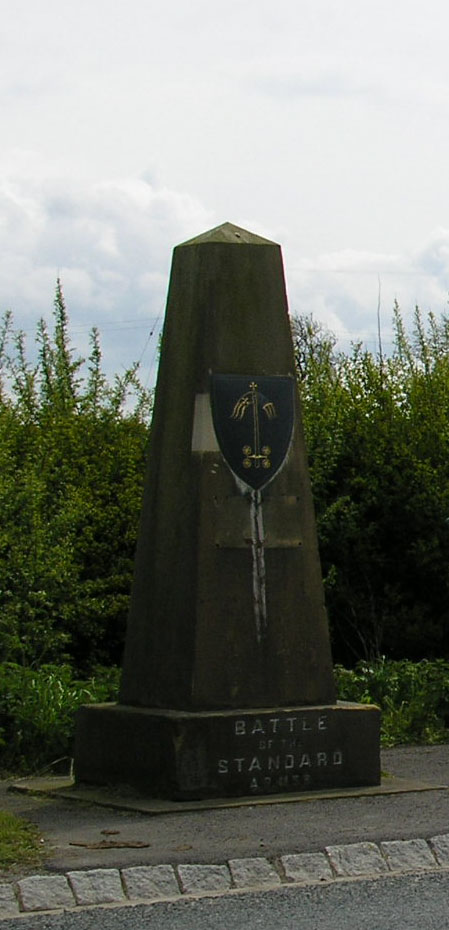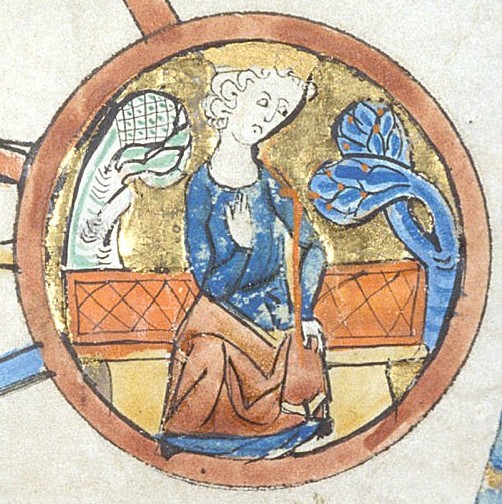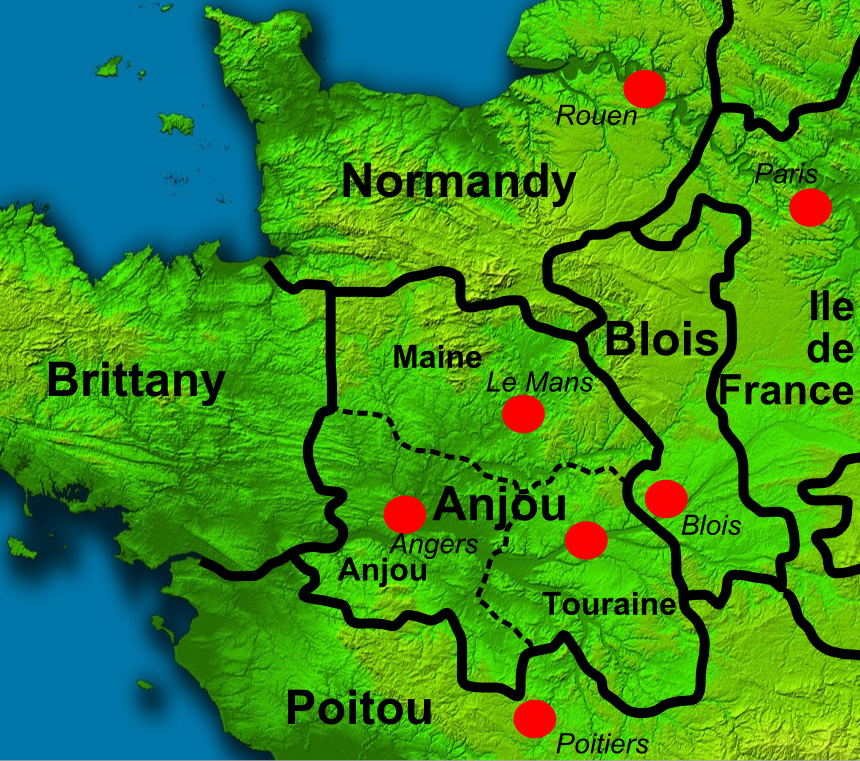|
Thurstan
:''This page is about Thurstan of Bayeux (1070 – 1140) who became Archbishop of York. Thurstan of Caen became the first Norman Abbot of Glastonbury in circa 1077.'' Thurstan or Turstin of Bayeux ( – 6 February 1140) was a medieval Archbishop of York, the son of a priest. He served kings William II and Henry I of England before his election to the see of York in 1114. Once elected, his consecration was delayed for five years while he fought attempts by the Archbishop of Canterbury to assert primacy over York. Eventually, he was consecrated by the pope instead and allowed to return to England. While archbishop, he secured two new suffragan bishops for his province. When Henry I died, Thurstan supported Henry's nephew Stephen of Blois as king. Thurstan also defended the northern part of England from invasion by the Scots, taking a leading part in organising the English forces at the Battle of the Standard (1138). Shortly before his death, Thurstan resigned from ... [...More Info...] [...Related Items...] OR: [Wikipedia] [Google] [Baidu] |
Battle Of The Standard
The Battle of the Standard, sometimes called the Battle of Northallerton, took place on 22 August 1138 on Cowton Moor near Northallerton in Yorkshire, England. English forces under William of Aumale repelled a Scottish army led by King David I of Scotland. King Stephen of England, fighting rebel barons in the south, had sent a small force (largely mercenaries), but the English army was mainly local militia and baronial retinues from Yorkshire and the north Midlands. Archbishop Thurstan of York had exerted himself greatly to raise the army, preaching that to withstand the Scots was to do God's work. The centre of the English position was therefore marked by a mast (mounted upon a cart) bearing a pyx carrying the consecrated host and from which were flown the consecrated banners of the minsters of Durham, York, Beverley and Ripon: hence the name of the battle. This cart-mounted standard was a very northerly example of a type of standard common in contemporary Italy, where ... [...More Info...] [...Related Items...] OR: [Wikipedia] [Google] [Baidu] |
Henry I Of England
Henry I (c. 1068 – 1 December 1135), also known as Henry Beauclerc, was King of England from 1100 to his death in 1135. He was the fourth son of William the Conqueror and was educated in Latin and the liberal arts. On William's death in 1087, Henry's elder brothers Robert Curthose and William Rufus inherited Normandy and England, respectively, but Henry was left landless. He purchased the County of Cotentin in western Normandy from Robert, but his brothers deposed him in 1091. He gradually rebuilt his power base in the Cotentin and allied himself with William Rufus against Robert. Present at the place where his brother William died in a hunting accident in 1100, Henry seized the English throne, promising at his coronation to correct many of William's less popular policies. He married Matilda of Scotland and they had two surviving children, Empress Matilda and William Adelin; he also had many illegitimate children by his many mistresses. Robert, who invaded from Nor ... [...More Info...] [...Related Items...] OR: [Wikipedia] [Google] [Baidu] |
Ranulf Flambard
Ranulf Flambard ( c. 1060 – 5 September 1128) was a medieval Norman Bishop of Durham and an influential government minister of King William Rufus of England. Ranulf was the son of a priest of Bayeux, Normandy, and his nickname Flambard means incendiary or torch-bearer, and may have referred to his personality. He started his career under King William I of England, probably in the compilation of the Domesday Book of 1086, as well as being the keeper of the king's seal. On the death of William I, Ranulf chose to serve the new king of England, William Rufus. Under Rufus, he continued to hold the king's seal, and also became involved in the financial administration of the kingdom, where he quickly made a name for himself by his novel methods of raising revenue. He was given custody of a number of vacant ecclesiastical offices, administering at one point sixteen vacant bishoprics or abbeys. His many duties have led to him being considered the first Chief Justiciar of England ... [...More Info...] [...Related Items...] OR: [Wikipedia] [Google] [Baidu] |
Abbot Of Glastonbury
__NOTOC__ The Abbot of Glastonbury was the head (or abbot) of Anglo-Saxon and eventually Benedictine house of Glastonbury Abbey at Glastonbury in Somerset, England. The following is a list of abbots of Glastonbury: Abbots See also * Abbot's Kitchen, Glastonbury The Abbot's Kitchen is a mediaeval octagonal building that served as the kitchen at Glastonbury Abbey in Glastonbury, Somerset, England. It is a Grade I listed building. The abbot's kitchen has been described as "one of the best preserved mediev ... Notes Sources * * * * {{DEFAULTSORT:Abbot of Glastonbury * Lists of abbots History of Somerset Abbot of Glastonbury Abbot of Glastonbury ... [...More Info...] [...Related Items...] OR: [Wikipedia] [Google] [Baidu] |
Yorkshire
Yorkshire ( ; abbreviated Yorks), formally known as the County of York, is a historic county in northern England and by far the largest in the United Kingdom. Because of its large area in comparison with other English counties, functions have been undertaken over time by its subdivisions, which have also been subject to periodic reform. Throughout these changes, Yorkshire has continued to be recognised as a geographic territory and cultural region. The name is familiar and well understood across the United Kingdom and is in common use in the media and the military, and also features in the titles of current areas of civil administration such as North Yorkshire, South Yorkshire, West Yorkshire and the East Riding of Yorkshire. Within the borders of the historic county of Yorkshire are large stretches of countryside, including the Yorkshire Dales, North York Moors and Peak District national parks. Yorkshire has been nicknamed "God's Own Country" or "God's Own County" by its in ... [...More Info...] [...Related Items...] OR: [Wikipedia] [Google] [Baidu] |
Thomas II Of York
Thomas II (died 24 February 1114) was a medieval archbishop of York. Early life and career Thomas was the nephew of Thomas of Bayeux, archbishop of York,Greenway ''Fasti Ecclesiae Anglicanae 1066-1300: Volume 6: York: Archbishops'' and the son of the elder Thomas' brother Samson, Bishop of Worcester. He was a royal chaplain, and then Provost of Beverley Minster in 1092, both appointments he owed to his uncle.Burton "Thomas" ''Oxford Dictionary of National Biography He was raised in the cathedral chapter at York, and the clergy of York trusted him,Vaughn ''Anselm of Bec and Robert of Meulan'' pp. 336-357 and he proved himself devoted to York's cause against the primacy of Canterbury.Barlow ''English Church'' p. 43 Thomas' brother Richard became Bishop of Bayeux in about 1108, holding the post till his death in 1133.Barlow ''English Church'' p. 58 Thomas and Richard's sister, Isabelle of Douvres, was the mistress of Robert of Gloucester, and their son Richard was Bishop of Bay ... [...More Info...] [...Related Items...] OR: [Wikipedia] [Google] [Baidu] |
Stephen Of England
Stephen (1092 or 1096 – 25 October 1154), often referred to as Stephen of Blois, was King of England from 22 December 1135 to his death in 1154. He was Count of Boulogne '' jure uxoris'' from 1125 until 1147 and Duke of Normandy from 1135 until 1144. His reign was marked by the Anarchy, a civil war with his cousin and rival, the Empress Matilda, whose son, Henry II, succeeded Stephen as the first of the Angevin kings of England. Stephen was born in the County of Blois in central France as the fourth son of Stephen-Henry, Count of Blois, and Adela, daughter of William the Conqueror. His father died while Stephen was still young, and he was brought up by his mother. Placed into the court of his uncle Henry I of England, Stephen rose in prominence and was granted extensive lands. He married Matilda of Boulogne, inheriting additional estates in Kent and Boulogne that made the couple one of the wealthiest in England. Stephen narrowly escaped drowning with Henry I's son, ... [...More Info...] [...Related Items...] OR: [Wikipedia] [Google] [Baidu] |
Archbishop Of York
The archbishop of York is a senior bishop in the Church of England, second only to the archbishop of Canterbury. The archbishop is the diocesan bishop of the Diocese of York and the metropolitan bishop of the province of York, which covers the northern regions of England (north of the Trent) as well as the Isle of Man. The archbishop's throne (''cathedra'') is in York Minster in central York and the official residence is Bishopthorpe Palace in the village of Bishopthorpe outside York. The current archbishop is Stephen Cottrell, since the confirmation of his election on 9 July 2020. History Roman There was a bishop in Eboracum ( Roman York) from very early times; during the Middle Ages, it was thought to have been one of the dioceses established by the legendary King Lucius. Bishops of York are known to have been present at the councils of Arles ( Eborius) and Nicaea (unnamed). However, this early Christian community was later destroyed by the pagan Angl ... [...More Info...] [...Related Items...] OR: [Wikipedia] [Google] [Baidu] |
Audoen
Audoen (sometimes Audin or Ouen) was a medieval Bishop of Évreux in Normandy. He was the son of Anger, a canon of London, and brother of Thurstan, the Archbishop of York The archbishop of York is a senior bishop in the Church of England, second only to the archbishop of Canterbury. The archbishop is the diocesan bishop of the Diocese of York and the metropolitan bishop of the province of York, which covers .... Audoen served as bishop from 1113 to 1139.Spear "The Norman Empire and the Secular Clergy" ''Journal of British Studies'' p. 5 Citations References * Bishops of Évreux 12th-century French Roman Catholic bishops 1139 deaths Year of birth unknown {{france-RC-bishop-stub ... [...More Info...] [...Related Items...] OR: [Wikipedia] [Google] [Baidu] |
Pontefract
Pontefract is a historic market town in the Metropolitan Borough of Wakefield in West Yorkshire, England, east of Wakefield and south of Castleford. Historically part of the West Riding of Yorkshire, it is one of the towns in the City of Wakefield District and had a population of 30,881 at the 2011 Census. Pontefract's motto is , Latin for "After the death of the father, support the son", a reference to the town's Royalist sympathies in the English Civil War. Etymology At the end of the 11th century, the modern township of Pontefract consisted of two distinct and separate localities known as Tanshelf and Kirkby.Eric Houlder, Ancient Roots North: When Pontefract Stood on the Great North Road, (Pontefract: Pontefract Groups Together, 2012) p.7. The 11th-century historian, Orderic Vitalis, recorded that, in 1069, William the Conqueror travelled across Yorkshire to put down an uprising which had sacked York, but that, upon his journey to the city, he discovered that the cro ... [...More Info...] [...Related Items...] OR: [Wikipedia] [Google] [Baidu] |
Waltheof Of Melrose
Waltheof ( – 1159) was a 12th-century English abbot and saint. He was the son of Simon I of St Liz, 1st Earl of Northampton and Maud, 2nd Countess of Huntingdon, thus stepson to David I of Scotland, and the grandson of Waltheof, Earl of Northampton.Barlow ''The English Church 1066–1154'' p. 208-210 Whether as a result of being a younger son in the world of Norman succession laws, or being personally unsuited to court life, Waltheof chose a career in the church. Between 1128 and 1131 he entered Nostell Priory to become an Augustinian canon. His noble connections enabled him to rise quickly, and by 1139 he was Prior of Kirkham, North Yorkshire. Upon the death of Thurstan, Archbishop of York, in 1140, Waltheof was nominated to be his successor.Barlow ''The English Church 1066–1154'' p. 96 His candidacy was supported by William of Aumale, the Earl of York.Dalton "William Earl of York" ''Haskins Society Journal'' pp. 162–163 Stephen, probably sensing his links to D ... [...More Info...] [...Related Items...] OR: [Wikipedia] [Google] [Baidu] |
St Paul's Cathedral
St Paul's Cathedral is an Anglicanism, Anglican cathedral in London and is the seat of the Bishop of London. The cathedral serves as the mother church of the Diocese of London. It is on Ludgate Hill at the highest point of the City of London and is a Listed Building, Grade I listed building. Its dedication to Paul the Apostle dates back to the original church on this site, founded in AD 604. The present structure, dating from the late 17th century, was designed in the English Baroque style by Sir Christopher Wren. Its construction, completed in Wren's lifetime, was part of a major rebuilding programme in the city after the Great Fire of London. The earlier Gothic cathedral (Old St Paul's Cathedral), largely destroyed in the Great Fire, was a central focus for medieval and early modern London, including Paul's walk and St Paul's Churchyard, being the site of St Paul's Cross. The cathedral is one of the most famous and recognisable sights of London. Its dome, surrounded by ... [...More Info...] [...Related Items...] OR: [Wikipedia] [Google] [Baidu] |






